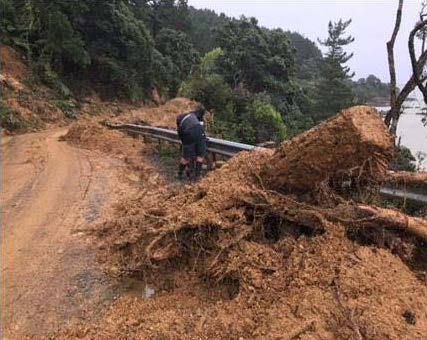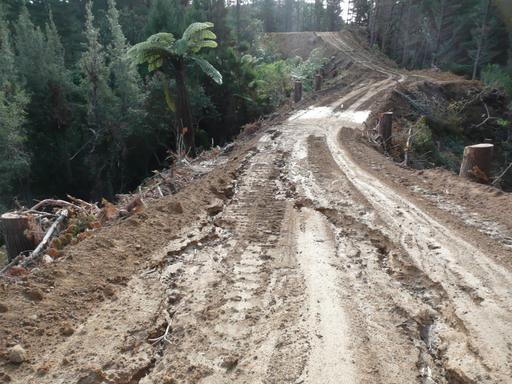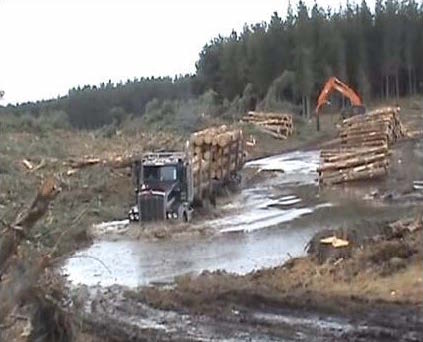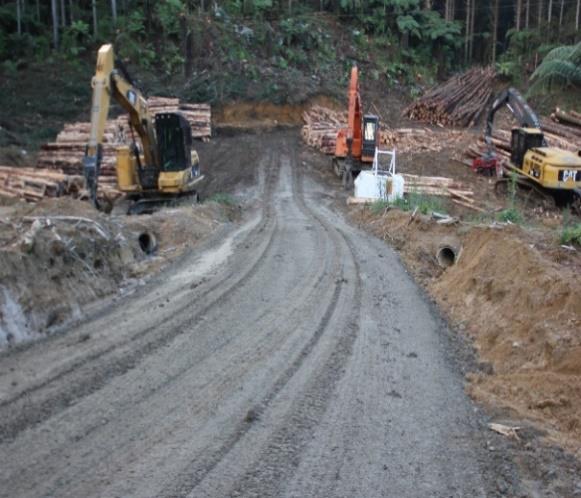Forest Harvesting Engineering – making it work for you
Q1. I’ve got some gear – should I be building the roads and landings?
Some forest owners like the idea of using their own gear, or friends or family to do road and landing construction for forest harvesting. This raises many issues and can result in a poorer outcome for all parties involved. Depending on the circumstances, harvesting contractors may not be able to get involved in harvesting operations alongside forest owners that insist on constructing the roads and landings themselves, or using their “own” contractor. The exception may be on easy terrain where there is minimal risk of road or landing failure, or when the contractor can meet contract pre-qualification criteria.



Q2. What could possibly go wrong?
- Road failure, resulting in compromised safety and disruption to loadout and cartage.
- Disrupted loadout causing log stocks to build and landing congestion, and in turn, compromised safety and production, resulting in higher logging costs.
- Landing failure, resulting in landing congestion, difficult working conditions for machinery, poor production and higher logging costs.
- Sub-standard earthworks construction practices resulting in a sediment discharge or debris flow onto neighbouring land or a water course, breaches of resource consent conditions, expensive remediation and possible prosecution under the RMA.
- Use of non-compliant machinery and unsafe earthworks construction practices could lead to safety breaches and possible prosecution under the H&S at Work Act 2015.
- The forest owner would be defined as an Officer of a PCBU and in the event of a serious harm accident could be prosecuted by Worksafe.
- Post-harvest legacy risks. Poorly constructed roads and landings can, and do fail well after harvesting is completed, particularly during intense rainfall events that are becoming more frequent. This aspect is getting more regulatory scrutiny and prosecutions are expected.
There are also likely to be arguments and blame relating to who takes responsibility for losses associated with the delays and higher costs incurred.
Q3. Who sets the standards for forest roads and landing construction?
Forest industry engineering standards, which forest owners are obliged to meet, are set by:
- The National Environmental Standard – Plantation Forestry (NES-PF) gazetted in August 2017 under the Resource Management Act 1991.
- The NZFOA New Zealand Environmental Code of Practice for Plantation Forestry; specifically, the Best Environmental Practices (BEPs) associated with Operational Planning, Earthworks and Waterway Crossings – updated 2015.
- The NZFOA New Zealand Forest Road Engineering Manual (2012) and subsequent Operator’s Guide, May 2017.
- Specific conditions set out in any Resource Consent issued by the Regional Council in respect of that operation.
- The Approved Code of Practice for Safety and Health in Forest Operations (MBIE, 2012).
Q4. Is there a payback on investing in well-constructed roads and landings?
In steep country harvest roading typically costs $5-10/m3 of logs extracted. This is relatively small compared to harvesting costs of $35-$45/m3 and log cartage costs of $25-35/m3. Not doing the roading right can have a material effect on the overall efficiency and cost of harvesting as well as a long-term adverse impact on the environment. Trying to save 20% in roading costs may save $2/m3 but it could easily impact on the efficiency of harvesting and cartage to a much greater extent which could add costs of more than $8/m3.
Q5. How can I best manage my forest engineering requirements?
- Roads and landings should integrate with the entire harvesting operation. Planning the location, road grades, geometry, and associated water controls requires specialist knowledge and skills. A DIY approach presents unnecessary risk.
- It is recommended that forest owners engage suitably qualified specialists with the knowledge and capability to align engineering standards and costs with harvest efficiency to provide the best overall stumpage returns.
- It is recommended that qualified civil engineers, equipped with the latest mapping, survey and design tools, support harvest managers in the development of optimal roading solutions.
- Aligning forest engineering with the harvest management under a single manager clarifies who is in control of the work-site. That matters under the PCBU requirements of the H&S at Work Act 2015.
Based on PF Olsen publication "Forest Harvesting Engineering – making it work for you"

 Farm Forestry New Zealand
Farm Forestry New Zealand